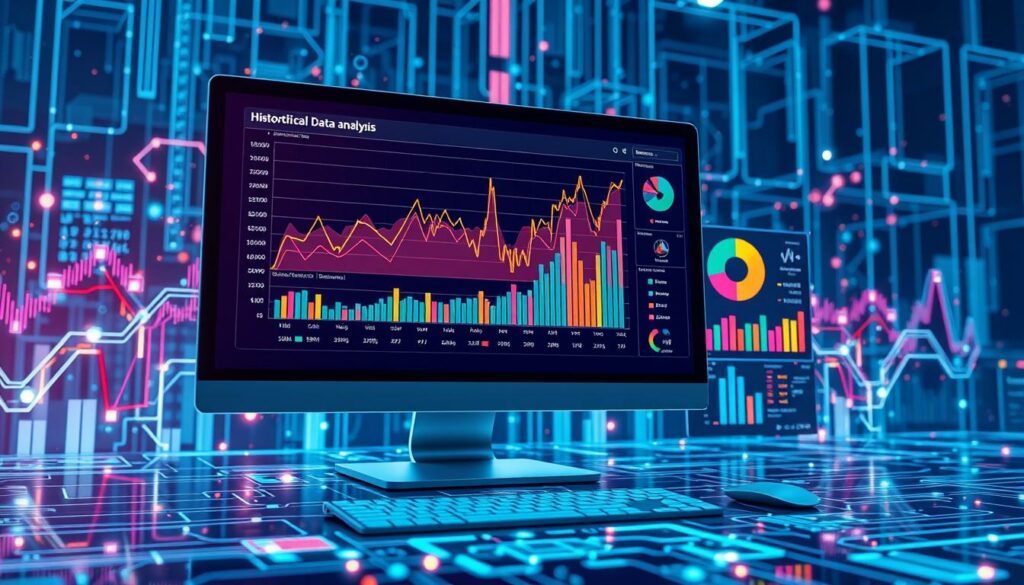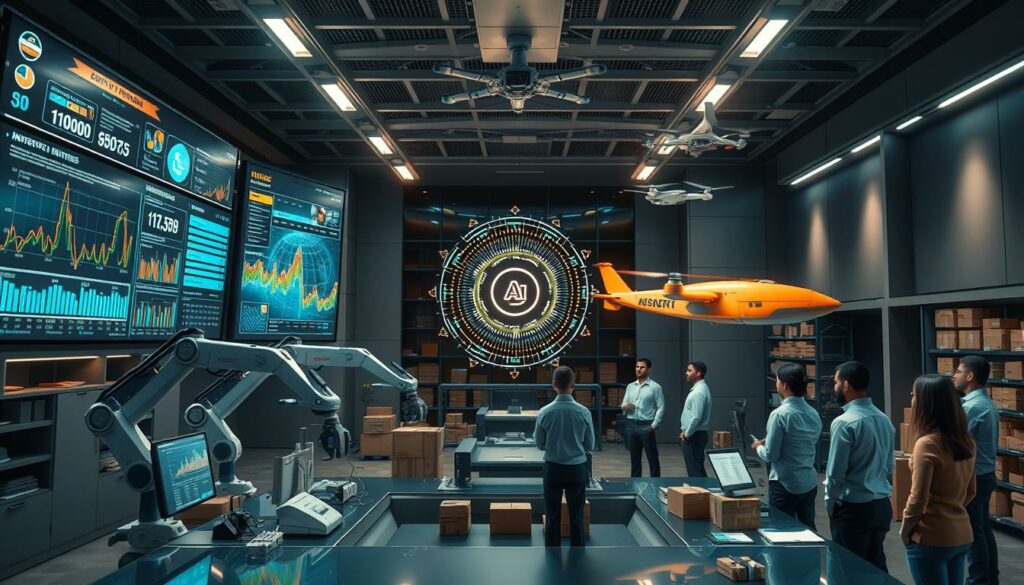The modern supply chain faces many challenges. These include managing sudden market demands and handling lots of data for decision-making. AI agents made for supply chain management use high-level analytics and real-time data. They also use machine learning to massively improve efficiency. These smart systems can foresee disruptions, make processes automatic, and offer insights. This leads to a better performing supply chain.
Key Takeaways
- More than half of the shipping costs for retail companies come from last-mile delivery.
- Organizations can save $37 million by reacting faster to supply chain disruptions. This is 45% of the average cost of disruptions in 2022.
- The NVIDIA business operations team has an AI planner. It talks with supply chain data, looking at thousands of scenarios at once.
- Demand forecasting is super important. Getting demand prediction right is key for making the supply chain better.
- Using AI for managing supply chains makes them way more efficient. It also cuts costs and makes customers happier.
Introduction to AI Agents in Supply Chain Management
AI agents use machine learning and data analytics to improve decision-making in supply chains. These tools make operations more efficient and adaptable. They help tackle issues in logistics by using intelligent automation in supply chain.
Machine learning is key to upgrading supply chain activities. AI agents analyze large amounts of data to forecast market changes. They keep supply chains flexible and strong, solving issues like delivery inefficiencies and high costs.
Interesting research shows how AI can save money in supply management:
- 15% on logistics
- 20% on inventory
- 40% on service
These savings show the positive impact of AI in supply chains. AI also helps in planning deliveries more efficiently by analyzing traffic, weather, and schedules. This reduces costs and saves time on shipping.
AI agents can predict supply chain issues before they happen. They look at risks from natural disasters, supplier problems, and political issues. This helps companies prepare and reduce disruption risks.
AI also improves how companies pick suppliers. It assesses suppliers on reliability, cost, quality, and location. This selection process boosts supply chain efficiency and lowers expenses.
AI enhances security to make supply chains and logistics safer. It helps prevent theft, fraud, and terrorism. In the future, we’ll see more self-driving cars and drones for better transportation.
Below is a table comparing traditional and AI-driven supply chains:
| Areas of Impact | Traditional Supply Chain | AI-Driven Supply Chain |
|---|---|---|
| Logistics Costs | High | Reduced by 15% |
| Inventory Management | Manual, prone to errors | Optimized, reduced by 20% |
| Service Efficiency | Inconsistent | Improved by 40% |
| Risk Management | Reactive | Proactive |
| Sustainability | Limited measures | Enhanced security, reduced incidents |
Benefits of Using AI Agents for Supply Chain Optimization
AI agents enhance the supply chain management in many ways. They boost efficiency by optimizing routes and managing inventory automatically. This allows companies to cut logistics costs by up to 15% and lower inventory levels by 20%, leading to big cost savings.
They also improve decision-making. By using predictive analytics and processing data in real-time, AI agents help companies become more agile and responsive. For example, using AI for risk management boosts performance. Up to 60% of organizations lose significant revenue due to supply chain inefficiencies, a problem AI can solve.
AI in supply chain management greatly improves customer service. It automates tasks like order tracking and dealing with returns, which increases customer satisfaction. AI can increase service levels by as much as 40%, with companies like GEP set to include AI frameworks in their platforms by 2025.
AI aids in more efficient route planning. This benefits the environment and lowers costs by reducing fuel use and ensuring timely deliveries. Effective route planning also supports sustainable business practices.
Better inventory management through AI keeps stock levels just right, lowering costs associated with too much or too little inventory. It also makes warehouses run more effectively. AI helps catch issues early, keeping the supply chain smooth and reliable.
By 2028, AI agents could make 15% of everyday decisions on their own, showing their growing importance in supply chain operations. This autonomy could streamline operations, improve cash flow, and increase resilience. To learn more about AI in logistics, you can schedule a consultation.
The global market for AI in supply chains is set to hit $41.23 billion by 2030. This shows a yearly growth rate of 38.8% from now until 2030. The rapid growth highlights AI’s game-changing role in supply chain management, stressing the need to include AI for better efficiency and cost savings.
Core Components of an AI Agent for Supply Chain
An AI agent for supply chain has key parts that work together. They aim to make supply chain management better. These parts include data analytics, machine learning models, and real-time data processing. Thanks to technology in logistics, the AI agent constantly learns from the past. It makes smart predictions and acts on them without human help.
At the core of these systems are smart algorithms. They can deal with huge amounts of data. By using AI, managing logistics has changed for the better. AI systems quickly go through a lot of data. This makes decisions better. For example, AI can predict what products will be needed in various places. It looks at past sales and current market trends to do this.
Also, AI-driven robots and AGVs in warehouses make processes smoother. They work all the time, increasing productivity. AI also makes shipping routes better by looking at traffic, vehicle conditions, and schedules. This leads to more efficient deliveries.
AI agents watch out for problems and changes in the market. They react fast to lessen negative effects. They also help the environment by making routes better, using less fuel, and forecasting better. Sensors and actuators are important too. They collect key data like temperature and movement. This data is vital for checking product conditions and making processes run on their own.
| Component | Function | Benefit |
|---|---|---|
| Data Analytics | Analyzes large data volumes | Enhances decision-making processes |
| Machine Learning Models | Learns from historical data | Improves predictions and actions |
| Real-Time Data Processing | Processes data instantly | Enables immediate responses |
| AI-Driven Robots | Operate around the clock | Streamlines processes |
| Shipping Route Optimization | Analyzes traffic, vehicle conditions | Ensures efficient deliveries |
| Disruption Monitoring | Monitors real-time changes | Minimizes impacts |
| Sensors and Actuators | Collects and acts on data | Automates processes, improves efficiency |
AI agents are great at using data from sensors and past records. They make routing better, cut down delivery times, and use less fuel. By always learning and changing, these AI agents keep logistics updated in quick-changing business settings.
How AI Agents Improve Demand Forecasting
AI agents have changed demand forecasting in the supply chain world. They use tools like Historical Data Analysis and process data in real time. This way, they can predict future demand very well. This helps companies manage their inventory better. They keep just the right amount of stock, cutting costs and waste.
Predictive analytics is a key part of this. By looking at Historical Data Analysis, AI agents find patterns. This helps companies get ready for changes in demand. They can make sure they have the right products when they need them.

AI agents process real-time data to quickly adjust to market changes. This is key in industries where seasonality and promotions matter. For example, real-time data helps make transport routes better. This cuts fuel use and costs, improving supply chain efficiency.
AI also makes customer service better by handling routine tasks fast. This leads to quicker response times and happier customers. Analyzing both historical and real-time data helps ensure customers know when products will be available and arrive.
AI’s impact on demand forecasting includes several key areas:
- Predictive Maintenance: AI helps plan maintenance to lessen downtime and keep machines running longer.
- Inventory Management: AI keeps an eye on stock and predicts when to order more, keeping stock levels just right.
- Route Optimization: It uses real-time data to find the best routes, lowering fuel use and costs.
- Customer Service: AI speeds up tasks, leading to faster replies and happier customers.
- Supply Chain Visibility: It spots issues and suggests actions to make better decisions.
In conclusion, AI agents boost demand forecasting by using Historical Data Analysis and real-time data processing. This leads to better efficiency, lower costs, and happier customers across the supply chain.
| Aspect | Benefits |
|---|---|
| Predictive Maintenance | Reduces downtime and extends equipment lifespan |
| Inventory Management | Optimizes stock levels, reducing carrying costs |
| Route Optimization | Reduces fuel consumption and transportation costs |
| Customer Service | Improves response times, enhancing satisfaction |
| Supply Chain Visibility | Enhances decision-making through real-time analysis |
Applications of AI Agents in Supply Chain Optimization
AI agents are changing how supply chains work, especially in Route Optimization. They use smart learning to forecast supplier capabilities and delays. This lets companies tweak their production plans to keep things running smoothly.
In inventory management, AI helps firms handle stock better. It prevents too much or too little inventory. This means resources are used well, cutting waste and using storage wisely.
- Optimized Logistics: In route optimization, AI agents find the best delivery routes. They save time and cut costs. This boosts delivery speed and lowers fuel use and emissions.
- Efficient Inventory Systems: AI agents predict stock needs by analyzing sales trends. They keep inventory levels just right, avoiding too much or too little stock.
- Risk Management in Supply Chain: AI agents assess risks from suppliers. They look at data to spot risky or harmful suppliers. This helps firms make safer, more informed choices.
New AI technologies are coming that will be even smarter. They will take on tougher tasks and predict better. This means businesses can get more efficient and scale up. They can let AI handle routine work and focus their people on big-picture strategies.
AI in supply chains can lower costs by 15-20% and make deliveries 20-30% more punctual. Also, decisions can be made 40% faster and operational efficiency can rise by 25%. These gains show how crucial AI agents are for making supply chains better today.
AI Agent for Supply Chain: Real-World Use Cases
In the ever-changing world of supply chain management, AI is making big changes. These real-world uses show us how AI improves operations, making things work better and cost less.
Take Amazon’s warehouses for example. They use AI to make things run smoother. AI helps them keep track of items, set up work schedules, and plan delivery routes better. This shows how AI can really change how things are done for the better.
Then there’s Maersk Line, the big shipping company. They use AI to find the best shipping paths. This smart planning means things arrive on time and they use less fuel. Maersk’s use of AI shows how it saves money and improves service.

A recent study by McKinsey found that one in three companies are using AI. Especially in making operations and stock management better. This shows AI has many uses that can make things work better.
The future of AI in supply chains is bright. By 2026, more than half of the top manufacturers will use AI. It will help them find issues before they become problems.
Microsoft Dynamics 365 Copilot is helping manage supply chains with AI. For example, Domino’s Pizza in the UK and Ireland uses it to guess customer demand better. This makes customers happier and ensures deliveries are on time.
United States Cold Storage also found success with AI. They made a system that schedules appointments automatically. This makes scheduling better, cuts down wait times, and makes logistics smoother.
If you want to learn more about AI in supply chains, check out this deep dive on AI Agent in Logistics and Supply Chain: Revolutionizing.
In summary, these real-world examples show us how AI is changing supply chains. It’s making operations smarter, saving money, and keeping competitive in the digital world. From predicting maintenance needs to optimizing routes, AI’s role is big and growing. It’s setting up a future that looks smarter and more efficient.
Examples of AI Solutions for Supply Chain Management
Using AI in supply chain management offers big benefits. Top industry leaders use AI to make processes smoother, increase efficiency, and boost their revenue.
Automated Warehouse Management dramatically changes supply chain operations. Zebra Technologies and C3 AI use smart algorithms for real-time inventory control. This lowers inventory costs and boosts service significantly. Early users saw inventory grow by 35% and service availability by 65%.
Vorto and FourKites are advancing logistics with AI. Vorto improves truck drivers’ lives and is used by big companies in North America. FourKites tracks over 3 million shipments a day, making routes better and deliveries on time.
Dynamic pricing strategies show AI’s potential. LivePerson’s AI solution adjusts prices by analyzing customer preferences and competitive pricing. This approach helps companies adapt to market changes and stay competitive.
| Company | AI Application | Impact |
|---|---|---|
| Zebra Technologies | Warehouse Operations | Boosted efficiency, reduced damage/loss |
| Vorto | Logistics Management | Enhanced truck driver quality of life |
| FourKites | Real-Time Shipment Tracking | Optimized routes, improved delivery times |
| LivePerson | Dynamic Pricing | Responsive to market conditions |
| C3 AI | Inventory Management | Real-time inventory control |
Coupa’s Supply Chain Modeler and Aspen Technology offer advanced AI analytics. They optimize logistics, procurement, production, and distribution. These tools let businesses test different scenarios to predict and improve outcomes.
Companies like H2O.ai and DataArt deliver AI-driven vehicles and fleet management. They aid in spotting mechanical issues early and planning the best routes. This keeps operations running without a hitch.
Conclusion
The use of AI in managing supply chains is changing the game. It introduces a new level of efficiency and competitiveness. By using AI, businesses can better manage their stock and predict product demand.
They can also make logistics smoother. AI technology allows for analyzing big data volumes. This helps in making smart decisions without human mistakes. As a result, operational costs go down. Major companies like Amazon, FedEx, and Walmart benefit from AI. They show how it improves customer service and operational effectiveness.
As AI technology gets better, its role in supply chains will deepen. By 2030, AI might make up 45% of the workforce. This underlines its growing impact. Nowadays, even people without AI skills can build AI solutions. This opens up AI technology to more users. AI’s benefits include better risk management. It can foresee and prevent possible problems, leading to stronger supply chains.
AI’s continued progress will bring more innovations in how we manage operations and supply chains. The future looks promising for AI in this field. It’s not just helping; it’s leading the way towards more effective and successful supply chain management. Companies investing in AI are set to lead in this competitive market. They will enjoy better processes, cost savings, and smarter decision-making. Using AI is now essential for top-notch logistics and supply chain achievements.
FAQ
What are AI agents for supply chain management?
AI agents in supply chain use smart tech to make better decisions. They predict problems, automate tasks, and improve efficiency with fast data analysis.
How do AI logistics solutions improve supply chain efficiency?
AI in logistics means smarter route planning and automatic handling of inventory. It leads to less waste, fewer manual tasks, and a flexible supply chain.
What are the benefits of intelligent automation in supply chain management?
Smart automation boosts operational speed and cuts costs. It also makes decision-making sharper, forecasting more accurate, and managing risks easier. These benefits make the supply chain stronger and more adaptable.
How does machine learning improve logistics in supply chain operations?
Machine learning looks at lots of data to make delivery routes better, predict demand, and manage stock. It lets companies make smart choices and use resources well.
What is cognitive computing in supply chain management?
Cognitive computing uses AI to think like humans and understand complex data. It helps solve tough logistics problems and boosts the supply chain’s performance.
Can AI agents assist with risk management in supply chains?
Yes, AI helps manage risks by looking at supplier issues, foreseeing disruptions, and offering solutions. It keeps the supply chain sturdier and more efficient.
How do AI solutions facilitate automated supply chain management?
AI uses smart systems to manage stock, forecast demand, and plan routes. This lowers the need for manual work and improves efficiency.
What are some real-world applications of AI agents in supply chain management?
Companies use AI for things like planning production, finding the best routes, and running warehouses automatically. These uses cut costs and boost efficiency.
How does AI technology impact inventory management?
AI uses past data and current trends to keep the right amount of stock. This avoids too much or too little inventory, meeting demand efficiently.
Why is real-time data processing important in supply chain management?
Real-time data lets companies analyze information fast and make quick decisions. It helps them stay flexible, optimize operations, and improve the supply chain.



